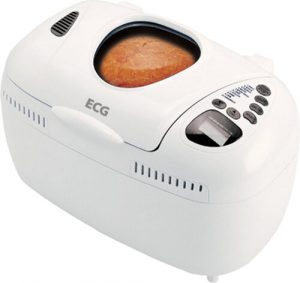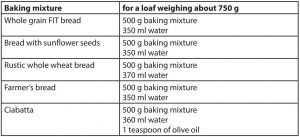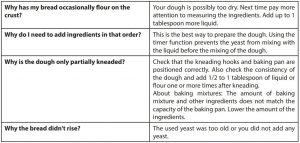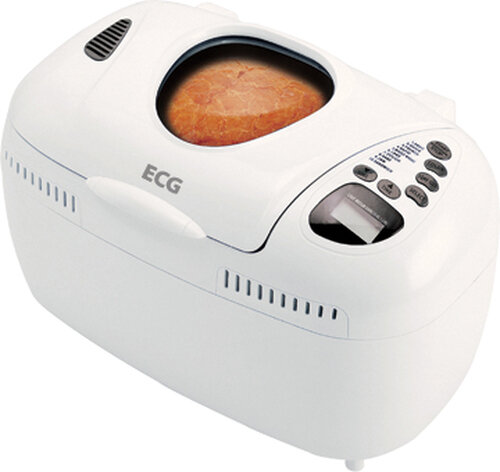Instruction Manual


ECG Bread Maker Recipes
Always read the safety&use instructions carefully before using your appliance for the first time. The user´s manual must be always included.
USEFUL INFORMATION ABOUT INGREDIENTS
FlourMost commercially available types of flour, such as wheat or rye flour, are suitable for baking. However, the designation of the type of flour may vary from one country to another. The „Gluten-Free Bread” baking program allows the use of gluten-free flour such as corn, buckwheat or potato flour. You can also use ready baking mixtures.
Programs 1 and 2 are ideal for adding small (10-20%) seeds or cream of wheat.If you are using a larger proportion of whole grains (70-95%), use program 3.The following types of flour appear in recipes:

YeastThe yeast contained in the yeast breaks down the sugar and other carbohydrates contained in the body andconverts it into carbon dioxide, causing the dough to rise. Yeast is available in various forms – such as dried yeast, fresh yeast or leaven yeast.
We recommend using a dried yeast for best results.If you use fresh yeast instead of dry yeast, follow the instructions on the package. Generally, 1 package of dry yeast contains about 21 g of fresh yeast and is suitable for about 500 g of flour. Always store the yeast in the refrigerator, since warmth spoils it. Check the expiration date before use. After opening the package, unused yeast should be carefully packed and stored in the refrigerator.
Note: We recommend using dry yeast for all the recipes in this book.
SugarSugar has a decisive influence on the degree of bake and taste of bread. The fermentating process is initiated by sugar and the dough will gradually rise. The recipes in this book assume the use of crystal sugar. Do not use icing sugar unless specifically stated. Artificial sweeteners are not suitable for any of these recipes.
SaltSalt is important for the taste and baking degree of the bread. Salt also helps to slow the rising of the dough. Therefore, do not exceed the amount of salt specified in the recipe. Salt may be omitted due to dietary restrictions. In this case, however, be aware that the dough may rise more quickly.
LiquidsLiquids such as water, milk or milk powder can be used to make bread. Milk enriches the taste of the bread andsoftens its crust, while the use of clean water ensures a crisper crust. Some recipes include the use of fruit juiceor other juice instead of water to give the bread some flavor.
EggsEggs enrich the dough and give the bread a softer texture. When baking bread according to the recipes in this book, use eggs as large as possible.
Baking fats, butter or oilBaking fats, butter or oil give the yeast bread the necessary suppleness. The unique crust and texture of French breads is due to the fact that no oil is used for baking it. However, the fat-containing bread will remain fresh for longer. If you take out the butter directly from the refrigerator, cut it into smaller pieces to mix it better into the dough when kneading.
Gluten free breadCeliac disease, or gluten intolerance, is a chronic, autoimmune disease whose triggers include glutencontaining foods. Gluten is a protein contained in wheat, barley, rye and most other cereals. In celiac patients, this protein causes irritation of the mucosa of the small intestine. People suffering from this disease can only eat special bread prepared from gluten-free flour.
However, baking bread, pastries and desserts from gluten-free flour requires some training. Gluten-free flour rises longer, absorbs fluids less and sticks less. Gluten-free flour should also be thickened for baking using special, gluten-free thickening agents. These include cream of tartar, maize or rice flour, maize-based baking powders, guar flour, pectin, kudzu root and others. Unfortunately, the gluten-free bread does not allow for the typical taste of fresh bread. The consistency of gluten-free flour bread will also be different from that of traditional wheat flour bread.
Measuring ingredientsIncluded in the packaging of your new home bakery are the following measuring scoops, which make it much easier to measure and prepare the ingredients needed to make bread.
- 1 measuring cup with volume marking
- 1 scoop corresponding to a tablespoon
- 1 scoop corresponding to a teaspoon
Place the measuring scoop on an even surface. Make sure to align the ingredient with the line on the measuring cup. Make sure that the measuring scoop is dry before measuring the dry ingredients.
BAKING TIPS
Baking in different climatic conditionsIf you are at higher altitudes, keep in mind that lower atmospheric pressure can result in faster fermentation of the yeast and thus faster rising of the dough. You can therefore use less yeast.In drier areas, the dough will tend to dry more and will require more liquid. Conversely, in humid areas, the flour will be wetter and will therefore absorb less fluid. Use more flour in these areas.
Ready baking mixturesIn this bakery you can also bake bread from a ready baking mixture. Follow the manufacturer’s instructions on the package. The table below provides an overview for measurements of some baking mixtures.

Slicing and storing breadFor best results, allow freshly baked bread to cool on the rack in the oven for 15 to 30 minutes. Use a special bread slicer or serrated knife for slicing. The bread can be stored at room temperature for up to 3 days in a suitable plastic bag or bread box. If you want to store the bread longer (up to 1 month), you must freeze it. Because home-made bread does not contain preservatives, it tends to spoil faster than bread purchased from a store.
Note: For use with this home bakery, we recommend especially ready-to-use baking mixtures that can be purchased at Lidl stores. Follow the instructions on the packaging.
RECIPES FOR BREAD WEIGHING ABOUT 1000 GRAMS
For best results, use a blender to knead the dough. Then put the finished dough in the baking pan. Use the button BREAD WEIGHT to enter 1000 g weight. Set the desired baking degree for crust. Please note that the stated ratio of ingredients and quantity is only approximate. Actual baking results may vary slightly.
Program 1: Regular bread
Sunflower bread
- 300 ml lukewarm milk
- 1 spoons of butter
- 540 g flour type 550
- 5 tablespoons of sunflower seeds
- 1 spoon of salt
- 1/2 teaspoon of sugar
- 1 dry yeast package
Yeast bread
- 50 g yeast
- 350 ml water
- 1.5 spoons of butter
- 1.5 teaspoon salt
- 1 teaspoon sugar
- 180 g rye bread type 997
- 360 g rye bread type 1050
- 1 dry yeast package
Farmer’s bread
- 300 ml milk
- 1.5 teaspoon salt
- 2 eggs
- 1.5 tablespoon butter/margarine
- 540 g rye bread type 1050
- 1 tablespoon sugar
- 1 dry yeast package
Potato bread
- 300 ml water or milk
- 2 spoons of butter
- 1 eggs
- 90 g cooked, mashed potatoes
- 1 spoon of salt
- 2 tablespoon sugar
- 540 g flour type 550
- 1 dry yeast package
Herb bread
- 350 ml buttermilk
- 1 spoon of salt
- 1.5 spoons of butter
- 1 tablespoon sugar
- 540 g flour type 550
- 4 tablespoons finely chopped parsley
- 3/4 dry yeast package
Pizza bread
- 300 ml water
- 1 tablespoon oil
- 1 spoon of salt
- 1 teaspoon sugar
- 1 teaspoon oregano
- 2 teaspoons grated parmesan cheese
- 50 g finely sliced Italian salami
- 540 g flour type 550
- 3/4 dry yeast package
Beer bread
- 150 ml water
- 150 ml lager
- 540 g flour type 550
- 3 tablespoons buckwheat flour
- 1.5 tablespoon bran
- 1 spoon of salt
- 3 tablespoons sesame seeds
- 1.5 tablespoons malt extract (syrup)
- 1/2 dry yeast package
- 150 ml yeast starter
Corn bread
- 350 ml water
- 1 spoons of butter
- 540 g flour type 550
- 3 tablespoons corn semolina flour
- 1/2 sliced apples with peel
- 3/4 dry yeast package
Program 2: French bread
“Classical” white bread
- 320 ml water or milk
- 2 spoons of butter
- 1.5 teaspoon salt
- 2 tablespoon sugar
- 600 g flour type 550
- 1 dry yeast package
Light white bread
- 320 ml water
- 20 g butter
- 1.5 teaspoon salt
- 1.5 teaspoon sugar
- 600 g flour type 405
- 1 dry yeast package
- 1 eggs
Honey bread
- 320 ml water
- 1.5 teaspoon salt
- 2.5 teaspoon olive oil
- 1.5 tablespoon honey
- 600 g flour type 550
- 1 dry yeast package
Poppy seed bread
- 300 ml water
- 540 g flour type 550
- 1 teaspoon sugar
- 1 spoon of salt
- 75 g ground poppy seed
- 1 spoons of butter
- 1 pinch of nutmeg
- 3/4 dry yeast package
- 1 tablespoon grated parmesan cheese
Paprika bread
- 310 ml water
- 1.5 teaspoon salt
- 1.5 teaspoon oil
- 1.5 teaspoon of paprika
- 530 g flour type 812
- 1 dry yeast package
- 130 g finely sliced red peppers
Program 3: Whole grain bread
Whole grain rye bread
- 75 g yeast
- 325 ml warm water
- 2 tablespoons honeydew
- 350 g whole grain rye flour
- 150 g whole wheat flour
- 1 tablespoon carob flour
- 1/2 tablespoon salt
- 1 dry yeast package
Spelt bread
- 350 ml buttermilk
- 360 g whole grain spelt flour
- 90 g whole grain rye flour
- 90 g spelt semolina
- 50 g sunflower seeds
- 1 spoon of salt
- 1/2 teaspoon of sugar
- 75 ml yeast starter
- 3/4 dry yeast package
Village bread with semolina
- 350 ml water
- 1 spoon of salt
- 2 spoons of butter
- 1.5 tablespoon honey
- 360 g bread flour type 1050
- 180 g whole wheat flour
- 50 g wheat semolina
- 3/4 dry yeast package
Whole grain bread
- 350 ml water
- 25 g butter
- 1 spoon of salt
- 1 teaspoon sugar
- 270 g bread flour type 1050
- 270 g whole wheat flour
- 3/4 dry yeast package
Rye bread
- 300 ml water
- 1.5 spoons of butter
- 1.5 tablespoon of wine vinegar
- 1 spoon of salt
- 1.5 tablespoon sugar
- 180 g rye bread type 1150
- 360 g bread flour type 1050
- 1 dry yeast package
Seven grain bread
- 300 ml water
- 1.5 spoons of butter
- 1 teaspoon salt
- 2.5 tablespoon sugar
- 240 g bread flour type 1050
- 240 g whole wheat flour
- 60 g seed mixture
- 3/4 dry yeast package
Brown bread
- 400 ml warm water
- 160 g flour type 550
- 200 g coarsely ground rye groats
- 180 g finely ground rye groats
- 1 spoon of salt
- 100 g sunflower seeds
- 100 ml molasses
- 1 dry yeast package
- 1 package yeast starter
Program 4: Sweet bread
Raisin bread
- 300 ml water
- 2.5 spoons of butter
- 1.5 tablespoon honey
- 1 spoon of salt
- 540 g flour type 405
- 100 g raisins
- 3/4 dry yeast package
Raisin-nut bread
- 300 ml water
- 1.5 spoons of butter
- 1 spoon of salt
- 1 tablespoon sugar
- 540 g bread flour type 405
- 100 g raisins
- 3 tablespoons chopped nuts
- 3/4 dry yeast package
Chocolate bread
- 400 ml milk
- 100 g low-fat cottage cheese
- 1.5 spoon of salt
- 1.5 teaspoon sugar
- 600 g whole wheat flour
- 10 tablespoons cocoa
- 100 g milk chocolate small pieces
- 1 dry yeast package
You can use milk chocolate or cooking chocolate. If you wash the dough after kneading with little milk, the crust becomes darker.
Sweet bread
- 300 ml water or milk
- 2 spoons of butter
- 2 eggs
- 1.5 teaspoon salt
- 1.5 tablespoon honey
- 600 g bread flour type 550
- 1 dry yeast package
Program 5: Quick bake
Quick white bread
- 360 ml water
- 5 tablespoon oil
- 4 teaspoon sugar
- 4 teaspoon salt
- 630 g flour type 405
- 1 dry yeast package
Pepper bread with almonds
- 300 ml water
- 540 g bread flour type 550
- 1 spoon of salt
- 1 teaspoon sugar
- 2 spoons of butter
- 100 g roasted almonds (slices)
- 1 tablespoon of green pepper in brine
- 3/4 dry yeast package
Carrot bread
- 330 ml water
- 1.5 spoons of butter
- 600 g bread flour type 550
- 90 g finely sliced carrots
- 2 teaspoon salt
- 1.5 teaspoon sugar
- 1 dry yeast package
Program 6: Kneading dough
Dough for pizza (for 2 pizzas)
- 300 ml water
- 1 spoons of olive oil
- 3/4 teaspoon salt
- 2 teaspoon sugar
- 450 g flour type 405
- 1 dry yeast package
Whole wheat pizza dough
- 300 ml water
- 1 spoons of olive oil
- 3/4 teaspoon salt
- 1 tablespoon honey
- 450 g whole wheat flour
- 50 g wheat germ
- 1 dry yeast package
- Roll out the dough and let it rise for about 10 minutes.
- Place the desired ingredients on the dough and bake the pizza for about 20 minutes at 180 ° C.
Kornspitz
- 200 ml water
- 50 g butter
- 3/4 teaspoon salt
- 1 eggs
- 3 tablespoon sugar
- 500 g flour type 1050
- 50 g wheat bran
- 1 dry yeast package
Pretzels
- 200 ml water
- 1/4 teaspoon salt
- 360 g bread flour type 405
- 1/2 teaspoon of sugar
- 1/2 dry yeast package
Shape the dough into pretzels. Wash the pretzels with a beaten egg and sprinkle with salt (approx. 1-2 tablespoons of coarse-grained salt for a total of 12 pretzels). Bake the pretzels at 230 ° C for about 15-20 minutes.
French baguettes
- 300 ml water
- 1 tablespoon honey
- 1 spoon of salt
- 1 teaspoon sugar
- 540 g flour type 550
- 1 dry yeast package
Shape the baguettes from the dough and cut the typical shape on the top of each. Allow the dough rest for about 30–40 minutes. Bake at 175 ° C for about 25 minutes.
Program 7: Pasta
- 5 eggs (at room temperature) or 300 ml of water
- 250 g plain wheat flour type 405
- 250 g coarse flour type 1050
Program 8 Buttermilk bread
Buttermilk bread (variant 1)
- 350 ml buttermilk
- 2 spoons of butter
- 2 teaspoon salt
- 3 tablespoon sugar
- 600 g flour type 1050
- 1 dry yeast package
Buttermilk bread (variant 2)
- 250 ml buttermilk
- 130 ml water
- 600 g flour type 1050
- 60 g rye bread type 997
- 1.5 teaspoon salt
- 1 dry yeast package
Yogurt bread
- 250 ml water or milk
- 150 g yogurt
- 1 spoon of salt
- 1 teaspoon sugar
- 500 g flour type 550
- 3/4 dry yeast package
Cottage cheese bread
- 200 ml water or milk
- 3 tablespoon oil
- 260 g cottage cheese (with 40% fat content)
- 600 g wheat flour
- 1.5 teaspoon salt
- 1.5 teaspoon sugar
- 1 dry yeast package
Program 9: Gluten free bread
Warning: Prior to baking gluten-free dough, be sure to thoroughly clean all internal parts of the appliance, especially the kneading hooks. Even a trace amount of wheat flour can cause an allergic reaction in celiacs.
Gluten-free potato bread
- 440 ml water
- 1.5 tablespoon oil
- 400 g gluten-free bread mix (eg “Mix B” from Schär)
- 1.5 teaspoon salt
- 1.5 teaspoon sugar
- 1.5 dry yeast package
- 230 g cooked potatoes, peeled and mashed
Gluten-free yogurt bread
- 350 ml water
- 150 g white yogurt
- 1.5 tablespoon oil
- 1.5 tablespoon of wine vinegar
- 100 g gluten-free flour(e.g. millet, rice or buckwheat flour)
- 400 g gluten-free bread mix (e.g.” Mix B” from Schär)
- 1.5 teaspoon salt
- 1.5 teaspoon sugar
- 1.5 dry yeast package
- 1 teaspoon guar or carob flour
Gluten-free seed bread
- 250 ml water
- 200 ml milk
- 1.5 tablespoon oil
- 500 g gluten-free bread mix
- 1.5 teaspoon salt
- 1.5 teaspoon sugar
- 1.5 dry yeast package
- 100 g seeds (e.g. sunflower)
Program 10: Cake mix
This program is used to process cake mixes.Follow the instructions on the package of the specific mixture.
Program 11: Marmalade
You can use your home bakery to make jams and marmalades. Even if you’ve never done this before, you should try it. You will get a particularly delicious, fresh fruit jam.
Proceed as follows:
- Wash fresh ripe fruit. It’s better to peel fruit such as apples, peaches, pears, etc. That have a hard peel.
- Always use the indicated amount as it is precisely fitted to the JAM program. Otherwise, the mixture will boil too soon and start spilling over.
- Weigh the fruit, cut it into small pieces (max. 1 cm) or mash it and place in a container.
- Add the gelling sugar in the required amount. Use only this type not the regular sugar.
- Mix the fruit with the sugar and start the program. It will run automatically from that moment.
- Rinse the prepared jam jars with hot water shortly before the program ends.
- Then fill the jars with jam and seal them well.
- Place closed jars upside down for about 5-10 minutes. This creates a vacuum in the jars and the jam stays fresh for longer.
Orange jam
- 350 g oranges
- 150 g lemons
- 500 gelling sugar
Strawberry jam
- 500 g of strawberries
- 500 gelling sugar
- 2–3 tablespoons lemon juice
Wild berries jam
- 500 g defrosted wild berries
- 500 gelling sugar
- 1 tablespoon lemon juice
Always mix all ingredients at once into a baking pan.
Enjoy your coffee!
The recipes in this book are provided without a guarantee. All ingredients and procedures are only a guide. Expand and customize these recipes based on your personal experience. We hope you enjoy the recipes and wish you a good appetite.
RECIPES TROUBLESHOOTING


The manufacturer takes no responsibility for printing errors contained in the product’s user’s manual
References
[xyz-ips snippet=”download-snippet”]

